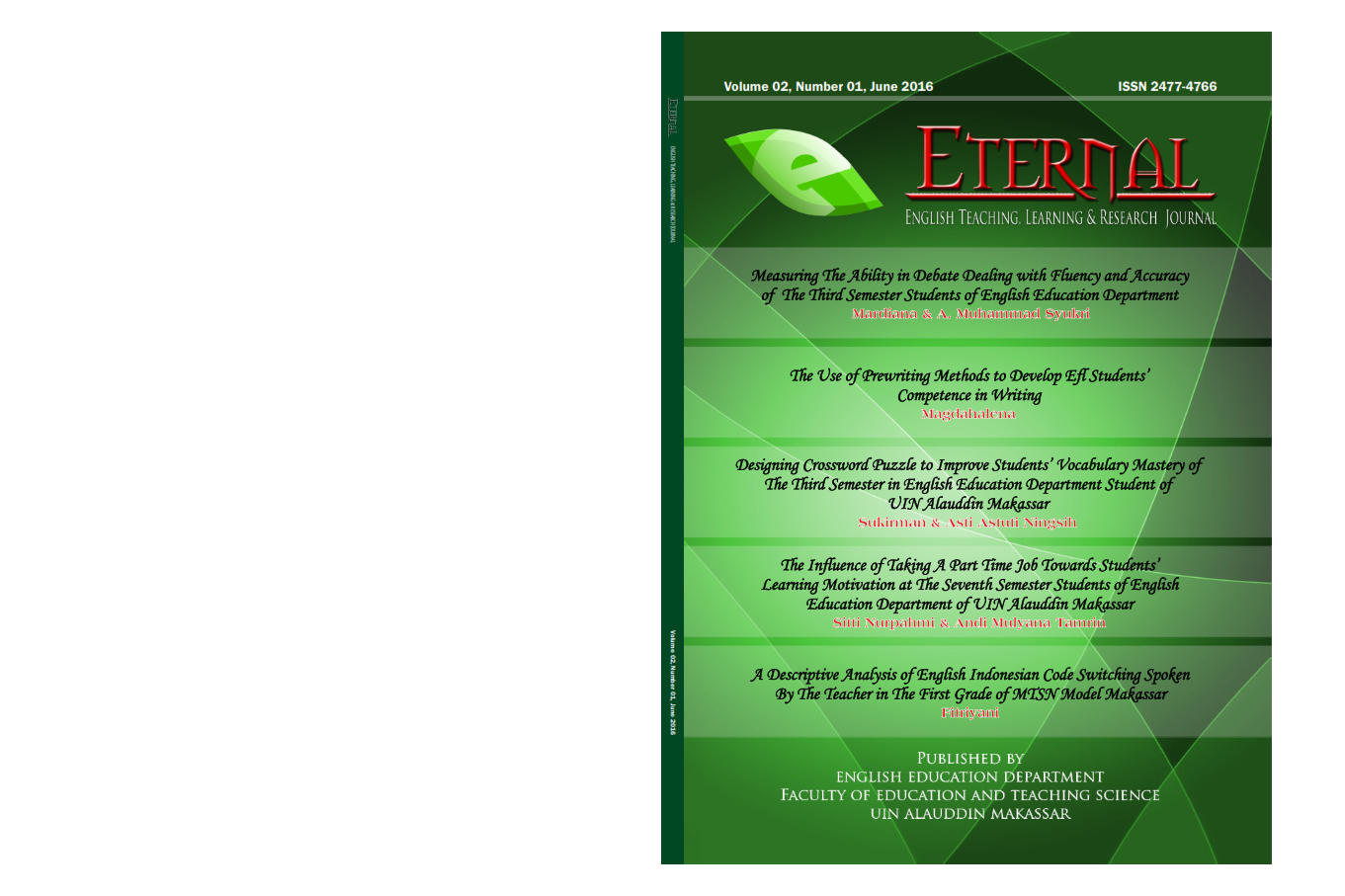A DESCRIPTIVE ANALYSIS OF ENGLISH INDONESIAN CODE SWITCHING SPOKEN BY THE TEACHER IN THE FIRST GRADE OF MTsN MODEL MAKASSAR
Abstract
The research aims to analyse the English Indonesia Code Switching Spoken by the Teacher in First Grade of MTsN Model Makassar. The principal issue into several subproblems or research questions such as 1) What are grammatical aspects of code switching in English Indonesian code switching spoken by the teacher in the first grade of MTsN Model Makassar?. 2) What are sosiolinguistic aspects of code switching in English Indonesian code switching spoken by the teacher in the first grade of MTsN Model Makassar?, and 3) What is the function of code switching in English Indonesian code switching spoken by the teacher in the first grade of MTsN Model Makassar?. The study was designed in the form of qualitative descriptive study. The subject in this study wasone of English teachers in the 7th grade of MTsN Model Makassar who teaches the VII.11 class. The data were collected by using the methods of recording and writing on note of what teacher said in teaching learning process, then collected it and classified based on grammatical aspect of code switching, sociolinguistic aspect, and the function (phatic function) of code switching. A grammatical focuses on the structural aspect of code switching. While, a sociolinguistic approach is concerned with the role of social factors of code switching. The result of this research showed that the grammatical aspect of code switching are extrasentential/tag switching, intersentential switching, and intra word of code switching. Sociolinguistic aspects of code switching are situational and metaphorical switching. The function of code switching are referential function, directive function, phatic function and metalingustic function. But this thesis only focused on phatic function to clarify or emphasize a message. The achievement of this research can be used to make easier in teaching foreign language and can be used as additional source and also can develop code switching field in the next research.Downloads
References
Auer, Peter. (1998). Code Switching in Conversation. London: Routledge.
Alfiyah, Nur. (2011). Code Switching and Code Mixing Used By Teachers In SMPN 4 Surabaya. Skripsi. Surabaya: IAIN Sunan Ampel.
Appel, R. & Muysken P. (2006). Language Contact and Bilingualism. Amsterdam: University Press.
Aranoff, M. And Rees-Miller. J. (2003).The handbook of Linguistics. Blackwell publisher: Oxford.
Arikunto, Suharsimi. (2013). Prosedure Penelitian: Suatu Pendekatan Praktik. Jakarta.
Arthur, Tom Mc. Code Mixing and Code Switching: Concise Oxford Compaining to the English Language.Bilingual Conversation. Journal of Pragmatics 33(12),1901-1925
Bunging, Burhan. (2011). Metodologi Penelitian Qualitative. Jakarta.
Chaer, Abdul and Leonie Agustina. (2004). Sosiolinguistik. Jakarta: PT Rineka Cipta.
Chomsky, Noam. (1965). Aspect of the theory of Syntax. Cambridge, MA: MIT press.
Crystal D, (1987).The Cambridge Encyclopedia of Language. Cambridge University. Press: Cambridge.
Emzir. (2011). Analisis Data:Metodologi Penelitian Kualitatif. Jakarta Utara: PT. Raja Grafindo Persada.
Fariekhah. (2012). Code Switching and Code Mixing used by teacher in SMPN 40 Surabaya. Skirpsi student of IAIN Sunana Ampel Surabaya.
Falahiyah. (2012). Code Switching and Code Mixing as a bridge in Speakig among first year student at MTs Al Amin Mojokerto. Skripsi at IAIN Sunan Ampel Surabaya.
Hadeli. (2006). Metode Penelitian Pendidikan. Jakarta: Quantum Teaching.
Holmes, Janet. (2015). An Introduction to Sosiolinguistic. United State of America: Longman, 1992.http://www.crisaps.org/newsletter/summer2009(10 july 2015).
___March. (1998). Code Switching in ConversationLanguage, Interaction and identity http://www.ude.es/dep/1X/cac/c-s/pres.html. ( 6 August 2015).
Nina. (2008). Code Switching and Code Mixing. Jakarta 2008 .(March 2008).
Ninaz. (2008). March. Code Switching and Code Mixing. Jakarta.
Rosyidi, Ajip. (1999). Bahasa Nusantara. Jakarta: PT. Dunia Pustaka Jaya.
Romaine, S. (1992). Bilingualism. Blackwell Publishers: Cambridge.
Setyaningsih, Nina.(2005). Code Switching in The Home-office Domain (A Case Study of the Daily Conversations among Workers at Salemba Emban PatriaSemarang). Semarang: Diponegoro University.
Skiba, R. (1997). Code Switching as a Countenance of Language Interference.The Internet TESL Journal. Vol. III. No: 10. (1997)
Sumarsono. (2002). Sosiolinguistik. Yogyakarta: Pustaka Pelajar.
Wardhaugh, Ronald. (1986). An Introduction to Sociolinguistics; Second Edition. Cambridge USA: Blackwell.
Wei, Li.(1986). The ‟Way‟ and ‟How‟ Questions in the Analysis of Conversational Code Switching. In Code Switching Conversation, Language Interaction & Identity, London: Routledge.
Whitman, Randal L.(1981). An Introduction to Lingustics. Canada: Simultaneously.
Wijaya,(2006). I Dewa Putu & Muhammad Rohmadi. Sosiolinguistik; Kajian Teori dan Analisis. Yogyakarta: Pustaka Pelajar.
Copyright notice:
- Authors retain copyright and grant the journal right of first publication with the work simultaneously licensed under a Creative Commons Attribution License that allows others to share the work with an acknowledgement of the work's authorship and initial publication in this journal.
- Authors are able to enter into separate, additional contractual arrangements for the non-exclusive distribution of the journal's published version of the work (e.g., post it to an institutional repository or publish it in a book), with an acknowledgement of its initial publication in this journal.
- Authors are permitted and encouraged to post their work online (e.g., in institutional repositories or on their website) prior to and during the submission process, as it can lead to productive exchanges, as well as earlier and greater citation of published work (See The Effect of Open Access)

